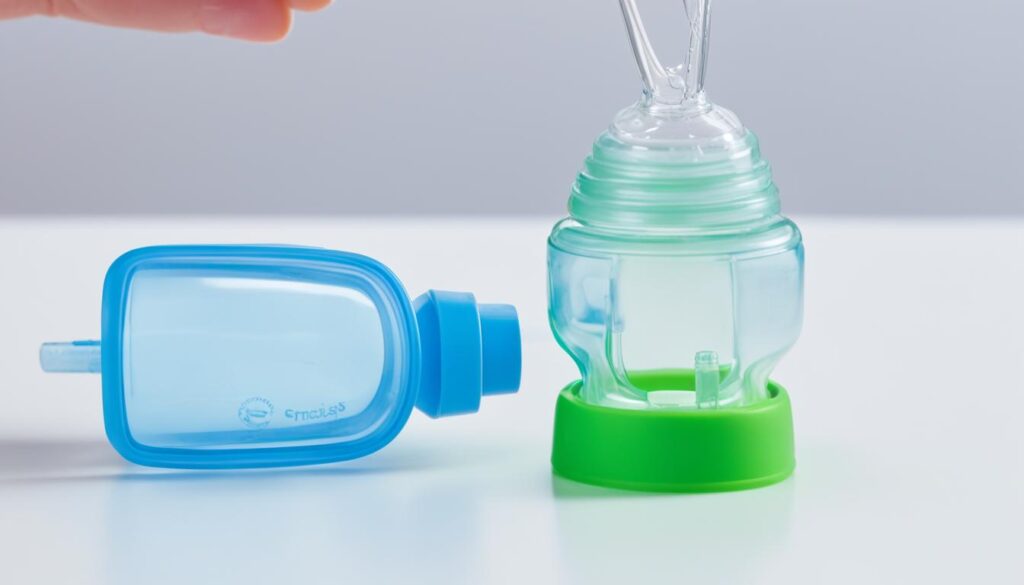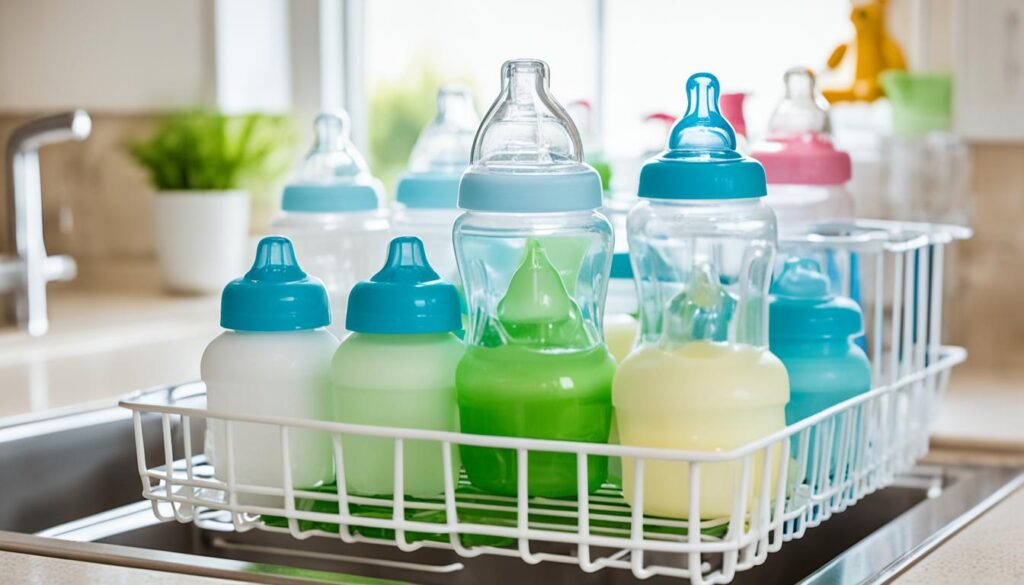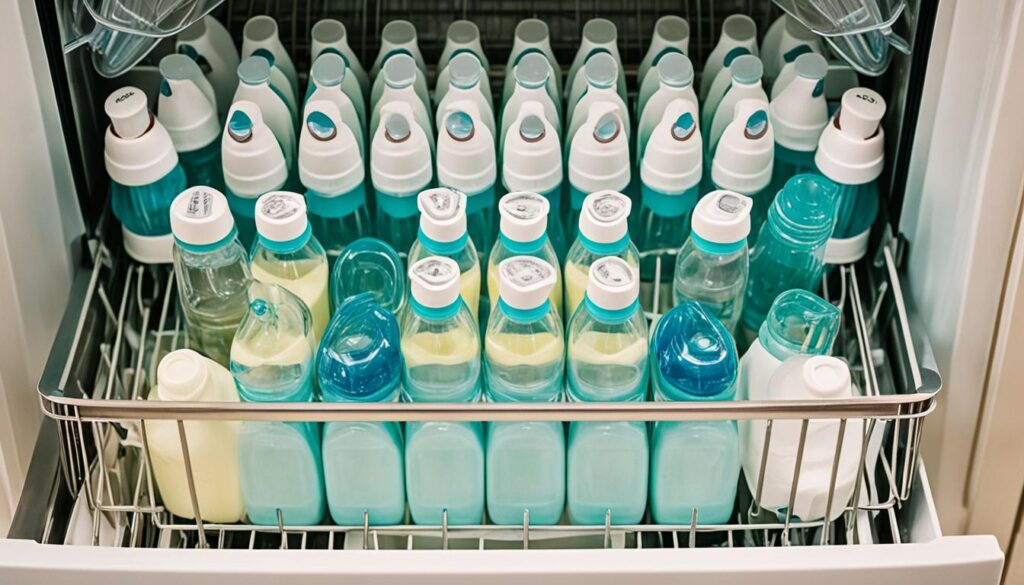As an Amazon Associate. I earn from qualifying purchases
As a parent, you’re always looking for ways to keep your little one’s things clean and safe. A common question is whether you can wash baby bottles in the dishwasher. Yes, you can wash your baby’s bottles in the dishwasher, but there are important things to remember for a thorough clean.
The dishwasher is a great tool for cleaning baby bottles. But, it’s key to follow the maker’s instructions and be careful to keep your baby safe. Let’s dive into the details of washing baby bottles in the dishwasher. This way, you can decide what’s best for your family.
Key Takeaways
- Dishwashers can be a convenient and effective way to clean baby bottles, but it’s important to follow the manufacturer’s guidelines.
- Proper disassembly, placement, and selection of the right dishwasher cycle are crucial for ensuring thorough cleaning and sanitization.
- Using a baby-safe detergent and inspecting for any residue after washing are essential steps to protect your baby’s health.
- Handwashing remains an option for those who prefer more hands-on control over the cleaning process.
- Proper drying and storage techniques are crucial for maintaining the cleanliness and safety of your baby’s bottles.
Dishwasher Safety for Baby Bottles
When washing baby bottles in the dishwasher, safety is key. Make sure they are dishwasher safe before loading. Check for labels or symbols that show they can go in the dishwasher.
Reading Labels and Symbols
Look for “dishwasher safe” text or symbols like a square with a cup and fork. You might also see a square with a wine glass and water droplets, or a plate with water droplets. A crossed-out dishwasher icon means it should be handwashed.
Rinsing Before Dishwashing
Even if bottles are dishwasher safe, rinse them in warm water first. This removes leftover milk or formula. It stops dried-on residue from forming, which is hard to clean later.
By following these steps, you keep your baby’s bottles safe and clean in the dishwasher. This keeps them healthy and safe.
“Proper dishwasher preparation is key to maintaining the cleanliness and safety of your baby’s bottles.”
Proper Disassembly of Baby Bottles

It’s key to clean your baby’s bottles well for their health and safety. A big part of this is taking apart the bottles before washing them. By breaking them down, you make sure every part gets cleaned, removing all milk or formula bits.
When you take apart a bottle, you remove the main bottle, cap, nipple, and any extra parts. This careful step lets each part get a deep clean in the dishwasher. It’s an easy but important step.
- Unscrew the bottle cap and remove the nipple.
- Detach any silicone or rubber seals or rings from the bottle and cap.
- Put all parts in the dishwasher’s top rack or a mesh bag for the best clean.
| Component | Disassembly | Placement |
|---|---|---|
| Bottle | Unscrew the cap | Top rack |
| Nipple | Remove from bottle | Top rack |
| Rings/Seals | Detach from bottle and cap | Mesh bag |
By carefully taking apart your baby’s bottles, you make sure they get a full clean. This small step is key to keeping their feeding items fresh and safe.
Using Baskets or Mesh Bags
When you wash baby bottles in the dishwasher, it’s key to keep small parts safe. Things like caps, nipples, and rings need a special spot. A dishwasher basket or mesh bag keeps them together and safe from getting lost or broken.
Using a dishwasher basket or mesh bag has many benefits. It helps protect the components of your baby’s bottles in several ways:
- Keeps small pieces organized and together
- Prevents parts from falling through the dishwasher rack
- Protects sensitive items from direct contact with high heat and water pressure
- Ensures thorough cleaning while maintaining the integrity of the bottle components
Getting a good dishwasher basket or mesh bag makes cleaning easier. It also gives you peace of mind. You’ll know your baby’s bottles are being washed and protected right.
When picking a dishwasher basket or mesh bag, choose one made for small parts. It should also handle the dishwasher’s heat well. This keeps your bottle parts in great shape for the next time you need them.
Bottle Placement in the Dishwasher

When washing baby bottles in the dishwasher, how you place them matters. Put disassembled baby bottles down on the top rack. This way, you avoid heat damage and make sure water drains well.
Facing Down on Top Rack
Putting bottles down on the top rack keeps them away from the hot bottom of the dishwasher. This is crucial for plastic bottles, which can warp or melt from too much heat. Facing them down shields them from these dangers.
Preventing Heat Damage
Also, facing bottles down helps water and detergent drain out. This stops residue from building up inside, which could be bad. So, your bottles come out clean, safe, and ready for next time.
| Bottle Placement | Benefits |
|---|---|
| Facing down on top rack |
|
Selecting the Right Dishwasher Cycle
Choosing the right dishwasher cycle is key when washing baby bottles. A sanitizing cycle is perfect for cleaning them thoroughly. These cycles use high temperatures to kill bacteria and clean deeply.
If your dishwasher doesn’t have a sanitizing cycle, go for a normal or heavy cycle instead. These cycles are longer and hotter, making them great for cleaning baby bottles well.
Sanitizing Cycle Temperatures
The temperature is crucial for killing germs in baby bottles. Sanitizing cycles get hot enough to kill harmful bacteria. This means your baby’s bottles will be clean and safe.
“Ensuring your baby’s bottles are properly sanitized is crucial for their health and well-being. The right dishwasher cycle can make all the difference.”
Remember, the best temperature may vary by dishwasher model. Always check your user manual or contact the manufacturer for the best sanitizing cycle temperature settings.
Can I Wash Baby Bottles in Dishwasher?

Cleaning your baby’s bottles in the dishwasher can be easy and effective. But, you must follow the right steps to make sure they’re clean and safe. Knowing what materials are safe for the dishwasher, taking apart the bottles, and choosing the right cycle and detergent helps. This way, you save time and energy while keeping your baby’s bottles clean.
Most baby bottles are dishwasher safe, but always check the manufacturer’s guide. Choose bottles made from durable, heat-resistant materials like glass, stainless steel, or BPA-free plastic. Don’t use bottles with complex designs or fragile parts, as they might not handle the dishwasher’s heat and pressure well.
Before putting the bottles in the dishwasher, take them apart fully. Remove any silicone nipples, rings, or lids to clean and sanitize each part. Taking them apart helps the dishwasher clean and sanitize the bottles better.
- Check the manufacturer’s instructions for dishwasher-safe materials.
- Disassemble the bottles completely, removing all parts.
- Place the bottles and their parts on the top rack of the dishwasher, facing down.
- Use a gentle, fragrance-free detergent made for baby items.
- Select the sanitizing cycle or the highest temperature setting for a deep clean.
By doing these steps, you can safely wash your baby’s bottles in the dishwasher. This ensures they’re clean, safe, and ready for use. Taking good care of your dishwasher and making sure everything is sanitized is key. It keeps your baby’s bottles in top shape and keeps your baby healthy.
Choosing Baby-Safe Detergent
When washing your baby’s bottles, not all detergents are the same. Some have harsh chemicals or strong smells that can be bad for your baby. It’s important to pick a baby-safe detergent that is gentle and effective.
Mild and Fragrance-Free
Choose mild and fragrance-free dishwasher detergents for your baby’s bottles. These formulas clean well without leaving harsh chemicals or strong smells. It’s key to skip unnecessary fragrances because they can bother your baby’s skin and breathing.
Pediatrician-Approved Options
For extra peace of mind, go for pediatrician-approved detergents made for baby bottles and feeding items. These products are tested and recommended by doctors. They meet the top safety and effectiveness standards.
| Detergent | Mild | Fragrance-Free | Pediatrician-Approved |
|---|---|---|---|
| Seventh Generation Free & Clear Dishwasher Detergent | ✓ | ✓ | ✓ |
| Method Dish Soap, Baby Bottle | ✓ | ✓ | ✓ |
| Mrs. Meyer’s Clean Day Dish Soap, Baby Blossom | ✓ | ✓ | ✓ |
By picking a baby-safe detergent that’s mild, without fragrance, and approved by doctors, you know your baby’s bottles are clean and safe.
Inspecting for Residue After Washing
After washing your dishwasher, check each baby bottle for leftover residue. Even with a good dishwasher, things like hard water or certain detergents can leave behind cloudy dishes and residue.
If you see milk left behind, you might need to run the bottles through another cycle or wash them by hand. Regular checks and residue inspection help keep your dishwasher working well. This keeps your baby’s bottles clean.
- Carefully inspect each bottle after the dishwasher cycle for any leftover residue.
- If you find any milk or food remnants, run the bottles through another cycle or handwash them.
- Regularly maintain your dishwasher to ensure optimal performance and prevent residue buildup.
“Keeping baby’s bottles free of any residue is crucial for their health and safety. A thorough inspection after washing is a must-do step.”
Inspecting your baby’s bottles and keeping your dishwasher in good shape is key. It makes sure every feeding is safe and stress-free. Regular residue inspection and dishwasher maintenance are vital for a clean and healthy environment for your baby.
Proper Drying and Storage
After cleaning your baby’s bottles in the dishwasher, make sure to dry and store them right to avoid contamination. Let the bottles air-dry completely to get rid of any water that could cause mold or bacteria to grow.
Air-Drying Techniques
To dry your baby’s bottles, lay the clean parts on a clean, dry spot, with them facing down. This way, any water inside can drain out. Don’t use towels to dry them because they might bring in harmful germs.
Safe Storage Practices
When the bottles are dry, put them in a clean spot. Keep the lids on lightly or upside down to let air in and stop mold. This keeps your baby’s bottles clean and safe while they’re stored.
“Proper drying and storage are key to keeping your baby’s bottles clean and safe.”
Handwashing Baby Bottles

Handwashing baby bottles is often the best choice, especially for glass ones or those with delicate parts. It’s a gentle way to clean, ensuring everything gets properly cleaned without damage.
Step-by-Step Handwashing Guide
Handwashing your baby’s bottles is easy and safe. Here’s how to do it right:
- Take apart the bottle, including the nipple, ring, and bottle itself.
- Wash each part under warm water to get rid of dirt.
- Use mild, scent-free soap and a soft brush.
- Scrub each piece well, focusing on tricky spots.
- Rinse everything under clean water to get rid of soap.
- Let all parts air-dry on a clean surface. Make sure they’re dry before putting them back together.
Handwashing might take a little longer, but it’s worth it. It makes sure your baby’s bottles are really clean and safe. This way, you can relax knowing everything is taken care of.
Dishwasher Safety for Other Bottles
Baby bottles are a big concern when it comes to dishwasher safety, but other water bottles need attention too. From metal to plastic, knowing how to wash them can keep your reusable bottles in good shape.
Metal Water Bottles
Stainless steel water bottles are loved for their strength and being good for the planet. But, not all are safe for the dishwasher. Single-layer stainless steel bottles without special coatings or parts that could break are usually okay in the dishwasher. Yet, handwashing is best to avoid corrosion or damage.
Aluminum water bottles should never go in the dishwasher. The special lining can wear off, making the bottle less safe.
Plastic Water Bottles
Many plastic water bottles can handle the dishwasher’s heat and cleaning. But, always check what the maker says before putting them in the dishwasher. Some might warp, crack, or not work right if they get too hot.
Handwashing these bottles is often a better choice. It keeps them lasting longer and clean from harmful stuff.
Knowing if your water bottles, metal or plastic, can go in the dishwasher helps you take good care of them. It keeps your drinks clean and safe to drink.
| Bottle Type | Dishwasher Safe? | Recommended Cleaning Method |
|---|---|---|
| Single-layer Stainless Steel | Yes, if no powder coatings or sensitive components | Dishwasher or handwash |
| Aluminum | No | Handwash |
| Reusable Plastic | Varies, check manufacturer’s guidelines | Dishwasher or handwash |
Conclusion
Washing baby bottles in the dishwasher is a great way to keep them clean and safe. Just make sure to follow the right steps. Check if the bottles are safe for the dishwasher, take them apart, and use the correct cycle and detergent.
It’s important to keep your baby’s bottles clean for their health. With the right methods, you can be sure your baby’s bottles are clean and ready for use. Focus on dishwasher cleaning, baby bottle safety, and effective sanitizing to give your baby the best care.
Being dedicated to your child’s health is key in baby care. Stay updated and use best practices to keep your baby’s bottles clean and safe. This way, your baby’s bottles will always be ready to feed your growing family.
FAQ
How do I know if my baby bottles are dishwasher safe?
Look for “dishwasher safe” labels or symbols like a square with a cup and fork, or a plate with water droplets. A crossed-out dishwasher icon means they should be handwashed.
Do I need to rinse the bottles before putting them in the dishwasher?
Yes, rinse the bottles in warm water first. This removes any leftover milk or formula. It helps the dishwasher clean better and prevents dried-on residue.
How should I disassemble the baby bottles before washing them in the dishwasher?
Take apart the baby bottles so each part, like caps and nipples, can get cleaned. This ensures a deep clean by removing milk or formula from hidden spots.
What is the best way to position the baby bottles in the dishwasher?
Put the bottles facing down on the top rack. This avoids direct heat at the bottom that could harm them. It also helps water drain out, leaving no residue inside.
Can I wash all types of water bottles in the dishwasher?
No, not all bottles can be washed in the dishwasher. Stainless steel bottles are okay if they’re simple and not coated. But, always check the maker’s advice first. Aluminum bottles should not go in the dishwasher. Most reusable plastic bottles are dishwasher-safe, but always check the label.

